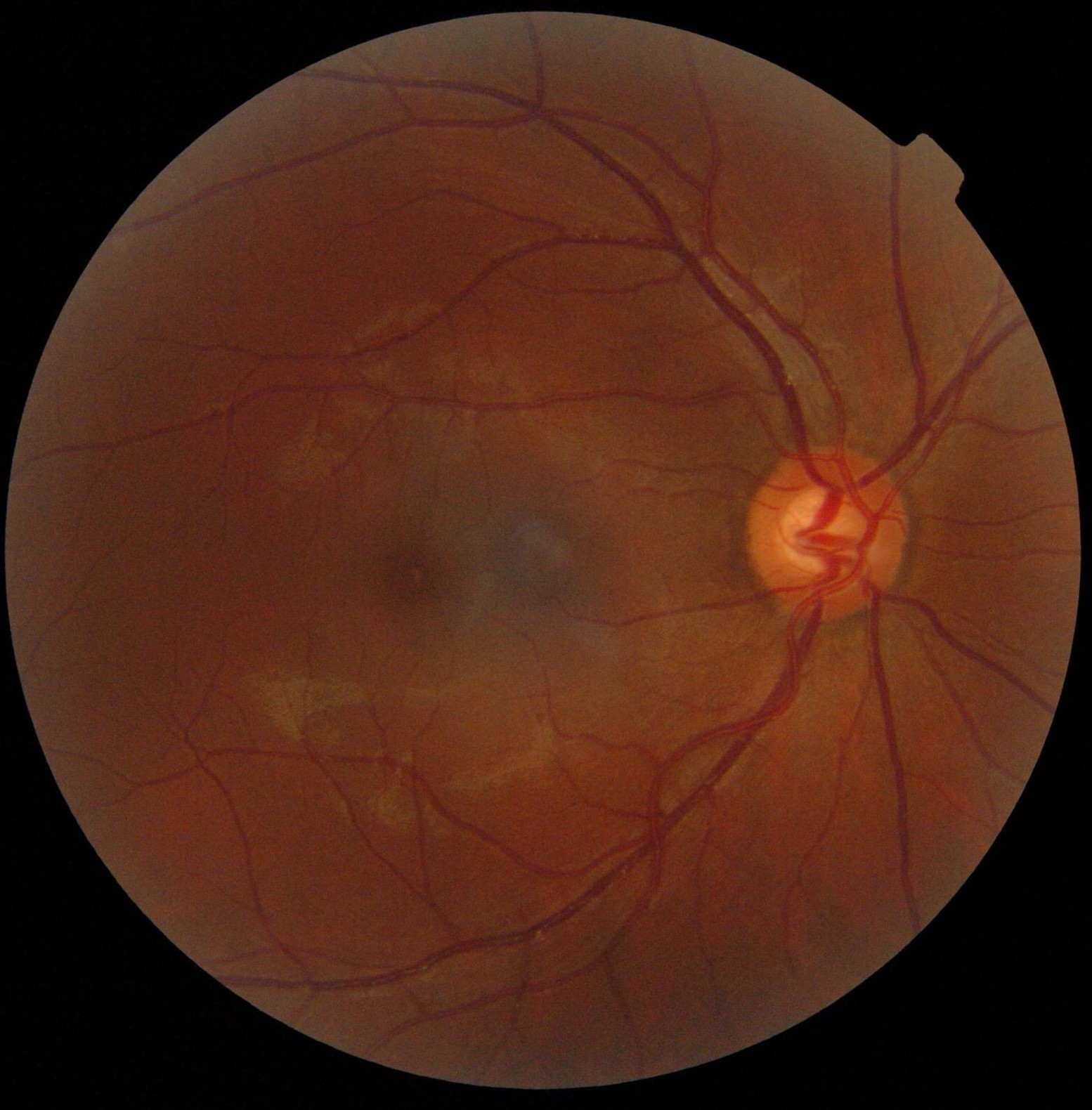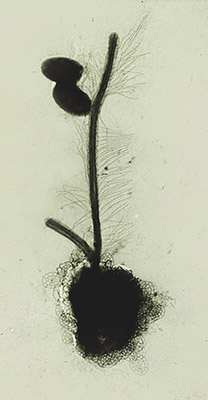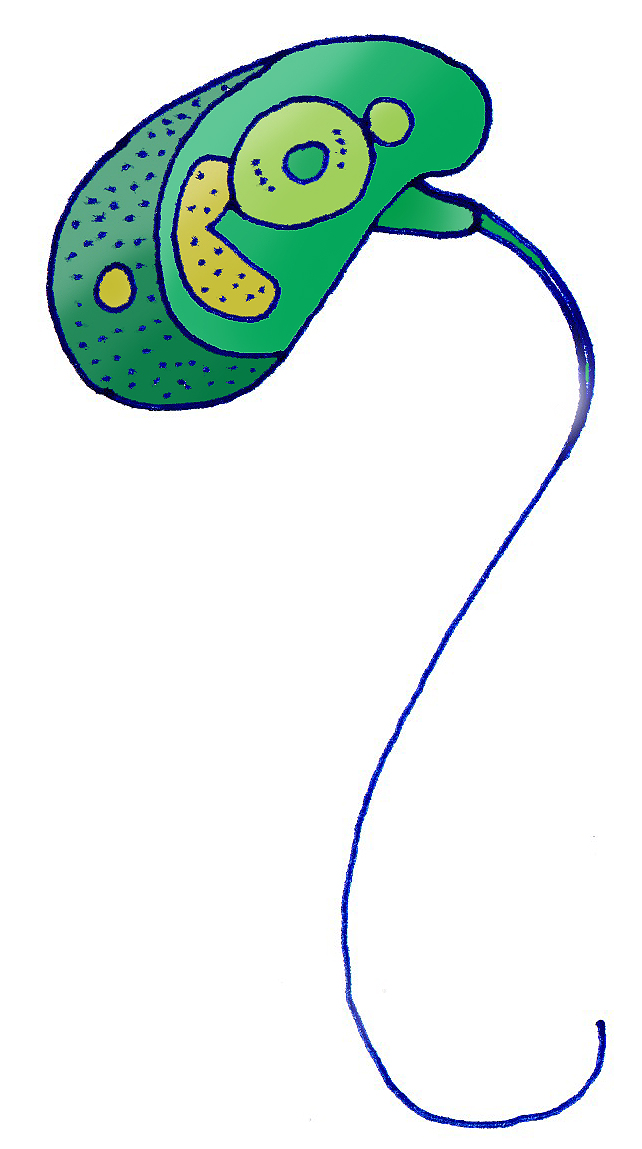|
Mastigonemes
Mastigonemes are lateral "hairs" that attach to protistan flagella. Flimsy hairs attach to the flagella of euglenid flagellates, while stiff hairs occur in stramenopile and cryptophyte protists.Hoek, C. van den, Mann, D. G. and Jahns, H. M. (1995). Algae : An introduction to phycology', Cambridge University Press, UK. Stramenopile hairs are approximately 15 nm in diameter, and usually consist of flexible basal part that inserts into the cell membrane, a tubular shaft that itself terminates in smaller "hairs". They reverse the thrust caused when a flagellum beats. The consequence is that the cell is drawn into the water and particles of food are drawn to the surface of heterotrophic species. Typology of flagella with hairs: *whiplash flagella (= smooth, acronematic flagella): without hairs but may have extensions , e.g., in Opisthokonta *hairy flagella (= tinsel, flimmer, pleuronematic flagella): with hairs (= mastigonemes ''sensu lato''), divided in: **with fine hairs (= ... [...More Info...] [...Related Items...] OR: [Wikipedia] [Google] [Baidu] |
Heterokonts
Heterokonts are a group of protists (formally referred to as Heterokonta, Heterokontae or Heterokontophyta). The group is a major line of eukaryotes. Most are algae, ranging from the giant multicellular kelp to the unicellular diatoms, which are a primary component of plankton. Other notable members of the Stramenopiles include the (generally) parasitic oomycetes, including ''Phytophthora'', which caused the Great Famine of Ireland, and ''Pythium'', which causes seed rot and damping off. The name "heterokont" refers to the type of motile life cycle stage, in which the flagellated cells possess two differently arranged flagella (see zoospore). History In 1899, Alexander Luther created the term "Heterokontae" for some algae with unequal flagella, today called Xanthophyceae. Later, some authors (e.g., Copeland, 1956) included other groups in Heterokonta, expanding the name's sense. The term continues to be applied in different ways, leading to Heterokontophyta being applied al ... [...More Info...] [...Related Items...] OR: [Wikipedia] [Google] [Baidu] |
Heterokonta
Heterokonts are a group of protists (formally referred to as Heterokonta, Heterokontae or Heterokontophyta). The group is a major line of eukaryotes. Most are algae, ranging from the giant multicellular kelp to the unicellular diatoms, which are a primary component of plankton. Other notable members of the Stramenopiles include the (generally) parasitic oomycetes, including ''Phytophthora'', which caused the Great Famine of Ireland, and ''Pythium'', which causes seed rot and damping off. The name "heterokont" refers to the type of motile life cycle stage, in which the flagellated cells possess two differently arranged flagella (see zoospore). History In 1899, Alexander Luther created the term "Heterokontae" for some algae with unequal flagella, today called Xanthophyceae. Later, some authors (e.g., Copeland, 1956) included other groups in Heterokonta, expanding the name's sense. The term continues to be applied in different ways, leading to Heterokontophyta being applied al ... [...More Info...] [...Related Items...] OR: [Wikipedia] [Google] [Baidu] |
Haptophyceae
The haptophytes, classified either as the Haptophyta, Haptophytina or Prymnesiophyta (named for ''Prymnesium''), are a clade of algae. The names Haptophyceae or Prymnesiophyceae are sometimes used instead. This ending implies classification at the class rank rather than as a division. Although the phylogenetics of this group has become much better understood in recent years, there remains some dispute over which rank is most appropriate. Characteristics The chloroplasts are pigmented similarly to those of the heterokonts, but the structure of the rest of the cell is different, so it may be that they are a separate line whose chloroplasts are derived from similar red algal endosymbionts. The cells typically have two slightly unequal flagella, both of which are smooth, and a unique organelle called a ''haptonema'', which is superficially similar to a flagellum but differs in the arrangement of microtubules and in its use. The name comes from the Greek ''hapsis'', touch, an ... [...More Info...] [...Related Items...] OR: [Wikipedia] [Google] [Baidu] |
Algal Anatomy
Algae (; singular alga ) is an informal term for a large and diverse group of photosynthetic eukaryotic organisms. It is a polyphyletic grouping that includes species from multiple distinct clades. Included organisms range from unicellular microalgae, such as ''Chlorella,'' ''Prototheca'' and the diatoms, to multicellular forms, such as the giant kelp, a large brown alga which may grow up to in length. Most are aquatic and autotrophic (they generate food internally) and lack many of the distinct cell and tissue types, such as stomata, xylem and phloem that are found in land plants. The largest and most complex marine algae are called seaweeds, while the most complex freshwater forms are the ''Charophyta'', a division of green algae which includes, for example, ''Spirogyra'' and stoneworts. No definition of algae is generally accepted. One definition is that algae "have chlorophyll ''a'' as their primary photosynthetic pigment and lack a sterile covering of cells around their rep ... [...More Info...] [...Related Items...] OR: [Wikipedia] [Google] [Baidu] |
Electron Microscopy
An electron microscope is a microscope that uses a beam of accelerated electrons as a source of illumination. As the wavelength of an electron can be up to 100,000 times shorter than that of visible light photons, electron microscopes have a higher resolving power than light microscopes and can reveal the structure of smaller objects. A scanning transmission electron microscope has achieved better than 50 pm resolution in annular dark-field imaging mode and magnifications of up to about 10,000,000× whereas most light microscopes are limited by diffraction to about 200 nm resolution and useful magnifications below 2000×. Electron microscopes use shaped magnetic fields to form electron optical lens systems that are analogous to the glass lenses of an optical light microscope. Electron microscopes are used to investigate the ultrastructure of a wide range of biological and inorganic specimens including microorganisms, cells, large molecules, biopsy samples, ... [...More Info...] [...Related Items...] OR: [Wikipedia] [Google] [Baidu] |
Visual Artifact
Visual artifacts (also artefacts) are artifact (error), anomalies apparent during visual representation as in digital graphics and other forms of imagery, especially photography and microscopy. In digital graphics * Image quality#Image quality factors, Image quality factors, different types of visual artifacts * Compression artifacts * Digital artifacts, visual artifacts resulting from digital image processing * Image noise, Noise * Screen-door effect, also known as fixed-pattern noise (FPN), a visual artifact of digital projection technology *Ghosting (television) *Screen burn-in * Distortion * Silk screen effect * Rainbow effect * Screen tearing * Moiré pattern * Color banding In video entertainment Many people who use their computers as a hobby experience artifacting due to a hardware or software malfunction. The cases can differ but the usual causes are: * Temperature issues, such as failure of cooling fan. * Unsuited video card (graphics card) drivers. * Drivers that have ... [...More Info...] [...Related Items...] OR: [Wikipedia] [Google] [Baidu] |
Light Microscopy
Microscopy is the technical field of using microscopes to view objects and areas of objects that cannot be seen with the naked eye (objects that are not within the resolution range of the normal eye). There are three well-known branches of microscopy: optical microscope, optical, electron microscope, electron, and scanning probe microscopy, along with the emerging field of X-ray microscopy. Optical microscopy and electron microscopy involve the diffraction, reflection (physics), reflection, or refraction of electromagnetic radiation/electron beams interacting with the Laboratory specimen, specimen, and the collection of the scattered radiation or another signal in order to create an image. This process may be carried out by wide-field irradiation of the sample (for example standard light microscopy and transmission electron microscope, transmission electron microscopy) or by scanning a fine beam over the sample (for example confocal laser scanning microscopy and scanning electro ... [...More Info...] [...Related Items...] OR: [Wikipedia] [Google] [Baidu] |
Stramenopile
Stramenopile is a clade of organisms distinguished by the presence of stiff tripartite external hairs. In most species, the hairs are attached to flagella, in some they are attached to other areas of the cellular surface, and in some they have been secondarily lost (in which case relatedness to stramenopile ancestors is evident from other shared cytological features or from genetic similarity). Stramenopiles represent one of the three major clades in the SAR supergroup, along with Alveolata and Rhizaria. Members of the clade are referred to as 'stramenopiles'. Stramenopiles are eukaryotes; since they are neither fungi, animals, nor plants, they are classified as protists. Most stramenopiles are single-celled, but some are multicellular algae including some brown algae. The group includes a variety of algal protists, heterotrophic flagellates, opalines and closely related proteromonad flagellates (all endobionts in other organisms); the actinophryid heliozoa, and oomycetes. The ... [...More Info...] [...Related Items...] OR: [Wikipedia] [Google] [Baidu] |
Prasinophyceae
The prasinophytes are a group of unicellular green algae. Prasinophytes mainly include marine planktonic species, as well as some freshwater representatives.Sym, S. D. and Pienaar, R. N. 1993. The class Prasinophyceae. In Round, F. E. and Chapman, D. J. (eds) ''Progress in Phycological Research'', Vol. 9. Biopress Ltd., Bristol, pp. 281-376. The prasinophytes are morphologically diverse, including flagellates with one to eight flagella and non-motile (coccoid) unicells. The cells of many species are covered with organic body scales; others are naked. Well studied genera include ''Ostreococcus'', considered to be the smallest (ca. 0.95 μm) free-living eukaryote, and ''Micromonas'', both of which are found in marine waters worldwide. Prasinophytes have simple cellular structures, containing a single chloroplast and a single mitochondrion. The genomes are relatively small compared to other eukaryotes (about 12 Mbp for ''Ostreococcus'' and 21 Mbp for ''Micromonas''). At least one spe ... [...More Info...] [...Related Items...] OR: [Wikipedia] [Google] [Baidu] |
Cryptophyceae
The cryptophyceae are a class of algae, most of which have plastids. About 220 species are known, and they are common in freshwater, and also occur in marine and brackish habitats. Each cell is around 10–50 μm in size and flattened in shape, with an anterior groove or pocket. At the edge of the pocket there are typically two slightly unequal flagella. Some exhibit mixotrophy. Characteristics Cryptophytes are distinguished by the presence of characteristic extrusomes called ejectosomes or ejectisomes, which consist of two connected spiral ribbons held under tension. If the cells are irritated either by mechanical, chemical or light stress, they discharge, propelling the cell in a zig-zag course away from the disturbance. Large ejectosomes, visible under the light microscope, are associated with the pocket; smaller ones occur underneath the periplast, the cryptophyte-specific cell surrounding. Except for ''Chilomonas'', which has leucoplasts, cryptophytes have one or two ch ... [...More Info...] [...Related Items...] OR: [Wikipedia] [Google] [Baidu] |
Pavlovales
: Pavlovaceae is a family of haptophyte The haptophytes, classified either as the Haptophyta, Haptophytina or Prymnesiophyta (named for '' Prymnesium''), are a clade of algae. The names Haptophyceae or Prymnesiophyceae are sometimes used instead. This ending implies classification at ...s. It is the only family in the order Pavlovales, which is the only order in the class Pavlovophyceae. It contains four genera, '' Diacronema'', '' Exanthemachrysis'', '' Pavlova'' and '' Rebecca''. References Haptophytes Eukaryote families {{Haptophyte-stub ... [...More Info...] [...Related Items...] OR: [Wikipedia] [Google] [Baidu] |
Cafeteria Roenbergensis FENCHEL And D J PATTERSON Schematic Drawing
A cafeteria, sometimes called a canteen outside the U.S., is a type of food service location in which there is little or no waiting staff table service, whether a restaurant or within an institution such as a large office building or school; a school dining location is also referred to as a dining hall or lunchroom (in American English). Cafeterias are different from coffeehouses, although the English term came from the Spanish ''cafetería'', same meaning. Instead of table service, there are food-serving counters/stalls or booths, either in a line or allowing arbitrary walking paths. Customers take the food that they desire as they walk along, placing it on a tray. In addition, there are often stations where customers order food, particularly items such as hamburgers or tacos which must be served hot and can be immediately prepared with little waiting. Alternatively, the patron is given a number and the item is brought to their table. For some food items and drinks, such a ... [...More Info...] [...Related Items...] OR: [Wikipedia] [Google] [Baidu] |






